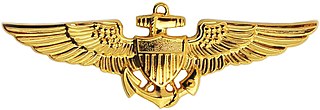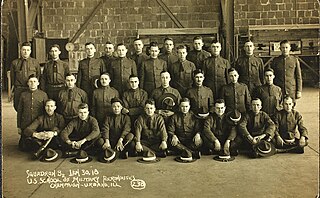
The Marine Aerial Navigator insignia is a military badge of the United States Marine Corps that is issued to Marine Corps enlisted personnel who complete flight training as a navigator on board Marine Corps aircraft. The Marine Aerial Navigator insignia is not issued to U.S. Naval aviation personnel and is the only independent aviation insignia issued to the Marine Corps.

Military badges of the United States are awards authorized by the United States Armed Forces that signify rating, qualification, or accomplishment in several career fields, and also serve as identification devices for personnel occupying certain assignments. Personal recognition is granted to service members by a number of awards and decorations. Together with military decorations, such badges are authorized for wear on military uniforms.

The United States Marine Corps (USMC), also referred to as the United States Marines or U.S. Marines, is a branch of the United States Armed Forces responsible for conducting expeditionary and amphibious operations with the United States Navy as well as the Army and Air Force. The U.S. Marine Corps is one of the four armed service branches in the U.S. Department of Defense (DoD) and one of the seven uniformed services of the United States.
The title flight officer was a military rank used by the United States Army Air Forces during World War II. It was also an air force rank in several Commonwealth nations where it was used for female officers and was equivalent to the rank of flight lieutenant. The term flight officer is sometimes used today to describe job title positions as aircrew members.
The Marine Aerial Navigator insignia is similar in appearance to the Naval Flight Officer insignia and is considered a "successor" to the Naval Aviation Observer (Navigation) insignia, issued between March 1945 and March 1947.
The Naval Flight Officer insignia is a breast insignia of the United States military which is awarded to those aviators of the Navy, Marine Corps and Coast Guard who have qualified as Naval Flight Officers (NFO) based on successful completion of flight training. The insignia is similar in design to the Naval Aviator insignia, consisting of a pair of golden wings, a shield, and crossed anchors.
To be awarded the Marine Aerial Navigator insignia, a service member must complete the Marine Aerial Navigator Course. The Marine Aerial Navigation School was stationed at Mather AFB, until that base was closed under the BRAC, upon which time it was moved to Randolph AFB. The Marine Aerial Navigation School remained at Randolph until the school [1] was decommissioned with the graduation of Class 04-01 on 31 July, 2004. Presently, personnel must obtain an equivalent formal course of another service and volunteer to fly as enlisted aircrew. Marine Aerial Navigators were eliminated with the introduction of the KC-130J aircraft. While training of Marine Aerial Navigators has ceased, they continue to fly on the 'legacy' KC-130T aircraft until their eventual replacement with KC-130J airframes.

Randolph Air Force Base is a United States Air Force base located at Universal City, Texas. The base is under the jurisdiction of the 902d Mission Support Group, Air Education and Training Command (AETC) and is the headquarters of AETC's Nineteenth Air Force.
Upon completion of training, and certification as a Marine Corps Navigator, the Marine Aerial Navigator insignia is presented. After designation, Marine Aerial Navigators serve in the Military Occupational Specialty (MOS) 7371 (Aerial Navigator-Trainee) while undergoing aircraft model-specific training and move into MOS 7372 (First Navigator) upon completion of their aircraft type training. Navigators that enter the warrant officer ranks move into MOS 7380 (Mission Specialist/Navigation Officer). There is no separate insignia worn by warrant officer navigators.











